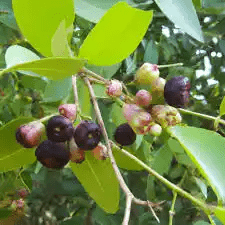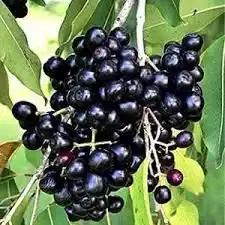Syzygium cumini, commonly known as Jamun, is a tropical evergreen tree native to the Indian subcontinent. This species holds significant cultural, medicinal, and culinary importance in various regions due to its diverse range of applications.
The botanical name, Syzygium cumini, reflects the scientific classification of this tree, which belongs to the Myrtaceae family.
The tree is renowned for its dark purple to black, plum-like fruits, which are not only delicious but also boast an array of health benefits. In terms of morphology, the Jamun tree is characterized by its dense, glossy foliage and a pyramid-shaped crown that provides ample shade. The bark of the tree is smooth and light gray when young, gradually turning rough and dark brown as the tree matures.
The elliptical leaves are opposite, simple, and exude a pleasant fragrance when crushed. The tree blooms with fragrant, small, white flowers, which later give way to the distinctive fruit, also known as Jamun or Java plum.
Jamun fruits are an integral part of traditional cuisines in South Asia. They have a unique sweet and tangy flavor, making them popular in various culinary applications.
Jamun is often consumed fresh, and its juice is used to make refreshing beverages, jams, and preserves. In addition to its culinary uses, Jamun is also a rich source of essential nutrients.
The fruit is known for its high levels of vitamin C, antioxidants, and phytochemicals, contributing to its reputation as a health-promoting food. Beyond its culinary significance, Jamun has a long history of use in traditional medicine.
Various parts of the tree, including the bark, leaves, and fruits, are employed in Ayurvedic and traditional medicine systems for their therapeutic properties.
The astringent properties of Jamun make it a popular remedy for digestive issues, including diarrhea and dysentery. Additionally, the fruit is believed to have anti-diabetic properties, with some studies suggesting that it may help regulate blood sugar levels.
The presence of bioactive compounds like anthocyanins, ellagic acid, and tannins in Jamun has led to its recognition as a powerful antioxidant.
These compounds contribute to the fruit’s ability to combat oxidative stress in the body, potentially reducing the risk of chronic diseases and supporting overall well-being.
Moreover, the antimicrobial properties of Jamun have been explored for their potential in fighting infections and promoting oral health.
In landscaping and horticulture, the Jamun tree is valued for its ornamental qualities. Its dense foliage and attractive flowers make it a popular choice for parks, gardens, and urban green spaces.
The tree’s adaptability to a range of soil types and climates further enhances its appeal as a landscaping element. Cultivation of Jamun has expanded beyond its native range, with the tree thriving in subtropical and tropical climates worldwide.
The propagation of Jamun is commonly done through seeds, although vegetative methods such as grafting and budding are also employed to maintain desirable traits in cultivated varieties.
Proper care, including adequate sunlight, well-drained soil, and regular watering, is essential for the successful cultivation of Jamun trees. In conclusion, Syzygium cumini, or Jamun, is a versatile and culturally significant tree with a wide array of uses.
From its delicious fruits that grace culinary creations to its therapeutic properties in traditional medicine, Jamun continues to play a vital role in the lives of many.
Whether enjoyed fresh, juiced, or integrated into medicinal remedies, the Jamun tree stands as a testament to the rich botanical diversity and cultural heritage of the regions it calls home.
The Botanical Description of Syzygium cumini (Jamun)
1. Tree Structure: Jamun trees are medium to large-sized, reaching heights of 15 to 25 meters. They have a dense and symmetrical crown, with branches spreading horizontally.
2. Leaves: The leaves of Syzygium cumini are glossy, elliptical, and opposite. They are 5 to 10 centimeters in length, with a smooth texture and a dark green color. The leaves play a crucial role in the tree’s photosynthetic processes.
3. Flowers: The tree produces small, fragrant, and white flowers in clusters. These flowers have a sweet aroma and are typically bisexual. The blooming period is usually during the summer months.
4. Fruit: The fruit of Syzygium cumini, known as Jamun, is a berry. It starts green and transitions to shades of purple or black as it ripens. The fruit has a distinct, sweet-sour taste and is a rich source of vitamins, minerals, and antioxidants.
5. Bark: The bark of the Jamun tree is smooth and grayish, developing a rough texture as the tree matures. It has been traditionally used in various herbal preparations in traditional medicine.
The Geographic Distribution of Syzygium cumini (Jamun)
1. Native Range: Syzygium cumini is native to the Indian subcontinent, thriving in the tropical and subtropical regions. It is commonly found in countries such as India, Bangladesh, Sri Lanka, and Myanmar.
2. Global Distribution: Due to its popularity and adaptability, Jamun trees have been introduced to various parts of the world with suitable climates. You can find cultivated Jamun trees in Southeast Asia, Australia, Africa, and even in some parts of the Americas.
3. Preferred Climate: Jamun trees prefer a tropical climate with high temperatures and moderate to high humidity. They can withstand both drought conditions and occasional flooding.
4. Soil Requirements: These trees can thrive in a variety of soil types, ranging from sandy loam to clayey soils. However, well-drained soils are crucial for optimal growth.
5. Altitude Range: While Jamun trees are typically found in lowland areas, they can be cultivated at altitudes up to 1,500 meters above sea level.
The Chemical Composition of Syzygium cumini (Jamun)
1. Nutritional Profile: Jamun fruit is a nutritional powerhouse, containing significant amounts of vitamins A and C, calcium, potassium, and various antioxidants. The fruit’s anthocyanin content is responsible for its characteristic color and potent antioxidant properties.
2. Phytochemicals: The leaves, bark, and seeds of the Jamun tree contain phytochemicals with potential medicinal properties. These include tannins, flavonoids, and polyphenols, which contribute to the tree’s therapeutic value.
3. Essential Oils: The leaves and bark of Syzygium cumini contain essential oils with antimicrobial and anti-inflammatory properties. These oils have been traditionally used in Ayurvedic medicine.
4. Glycemic Index: Jamun fruit has a low glycemic index, making it a suitable option for individuals managing blood sugar levels. The presence of jambosine and other compounds contributes to its anti-diabetic potential.
5. Medicinal Compounds: Various parts of the Jamun tree have been studied for their medicinal compounds, including anti-inflammatory, antimicrobial, and anti-cancer properties. The seeds, in particular, are rich in bioactive compounds with potential health benefits.
6. Anthocyanins: The purple-black color of Jamun fruit is due to the presence of anthocyanins, which not only give the fruit its appealing appearance but also contribute to its antioxidant and anti-inflammatory effects.
7. Jambosine: Jambosine, found in Jamun seeds, has been studied for its potential role in managing diabetes. It is believed to have hypoglycemic effects, helping regulate blood sugar levels.
8. Quercetin: Quercetin, a flavonoid present in Jamun, exhibits antioxidant properties and may contribute to the fruit’s overall health-promoting effects.
9. Ellagic Acid: Ellagic acid, found in Jamun fruit, has been associated with anti-cancer properties and may play a role in preventing the growth of cancer cells.
Syzygium cumini, or Jamun, is a remarkable tree with not only a delicious fruit but also a range of potential health benefits. From its botanical features to its global distribution and chemical composition, Jamun stands out as a valuable and versatile plant in various cultural and medicinal contexts.
Read Also: The Different Properties of Fresh Meat
The Medicinal Health Benefits Of Syzygium cumini (Jamun)

1. Blood Sugar Regulation: Jamun is renowned for its hypoglycemic properties, making it beneficial for individuals managing diabetes. The fruit helps regulate blood sugar levels, attributed to compounds like jambosine and ellagic acid.
2. Antioxidant Powerhouse: With a rich anthocyanin content, Jamun acts as a potent antioxidant. These compounds neutralize free radicals, protecting cells from oxidative stress and reducing the risk of chronic diseases.
3. Digestive Health: Jamun is known to aid digestion. The fiber content helps prevent constipation, while the presence of tannins may soothe gastrointestinal issues.
4. Oral Health Improvement: The astringent properties of Jamun contribute to improved oral health. The fruit is believed to strengthen gums, reduce plaque formation, and combat bad breath.
5. Weight Management: As a low-calorie and nutrient-dense fruit, Jamun can be a valuable addition to weight management plans. The fiber content promotes a feeling of fullness, aiding in appetite control.
6. Cardiovascular Health: The antioxidants and potassium in Jamun contribute to cardiovascular health. They help maintain blood pressure levels and support overall heart function.
7. Liver Health Support: Jamun is considered beneficial for liver health. Compounds in the fruit may help in detoxifying the liver and promoting its optimal function.
8. Anti-inflammatory Effects: The anti-inflammatory properties of Jamun make it valuable in managing inflammatory conditions, potentially providing relief from arthritis and related disorders.
9. Immune System Boost: With its vitamin C content and immune-boosting properties, Jamun contributes to a strengthened immune system, helping the body fight infections and illnesses.
10. Skin Health Enhancement: Jamun’s antioxidants play a role in promoting skin health. Regular consumption may contribute to a youthful complexion and help manage skin conditions.
11. Vision Protection: The presence of vitamin A and antioxidants in Jamun supports eye health. It may help prevent age-related macular degeneration and other vision issues.
12. Anti-cancer Properties: Certain compounds in Jamun, including ellagic acid, have been studied for their potential anti-cancer effects. While more research is needed, Jamun shows promise in cancer prevention.
13. Anti-bacterial Action: Jamun exhibits antibacterial properties, making it useful in preventing and managing bacterial infections, particularly in the digestive system.
14. Anti-viral Potential: Some research suggests that Jamun may have antiviral properties, contributing to its role in preventing and managing viral infections.
15. Respiratory Health Support: The anti-inflammatory effects of Jamun extend to respiratory health. It may help alleviate symptoms of respiratory conditions like asthma.
16. Bone Health Maintenance: Jamun contains minerals like calcium, which are essential for maintaining bone health. Regular consumption may contribute to strong and healthy bones.
The Methods of Usage to Achieve the Provided Health Benefits Of Syzygium cumini (Jamun)
1. Fresh Consumption: Enjoy Jamun in its fresh form to maximize the intake of nutrients and antioxidants. Include it in your daily fruit intake for overall health benefits.
2. Jamun Juice: Prepare fresh Jamun juice by blending the fruit with water. This can be a refreshing beverage with the added advantage of concentrated nutrients.
3. Jamun Seed Powder: The seeds of Jamun can be dried and ground into a powder. This powder can be consumed with water or added to smoothies for additional health benefits.
4. Jamun Supplements: Jamun supplements, including capsules or extracts, are available. These can be convenient for individuals who may not have access to fresh Jamun regularly.
5. Jamun in Culinary Creations: Incorporate Jamun into various culinary creations, such as salads, desserts, or jams. This adds a unique flavor while providing health benefits.
6. Jamun Tea: Infuse Jamun leaves into hot water to make a tea. This can be a soothing beverage with potential health-boosting properties.
7. Jamun Vinegar: Jamun vinegar can be prepared by fermenting the fruit. This vinegar can be used in cooking or consumed for its potential health advantages.
8. Ayurvedic Formulations: Explore Ayurvedic formulations that include Jamun as a key ingredient. These formulations may be designed to address specific health concerns.
The Side Effects Of Using Syzygium cumini Medicinal Plant
While Jamun is generally considered safe for consumption, it’s essential to be aware of potential side effects, especially when consumed in excess:
1. Hypoglycemia Risk: Individuals with diabetes should monitor their blood sugar levels carefully when consuming Jamun, as it may lower blood glucose levels.
2. Allergic Reactions: Some people may experience allergic reactions to Jamun. If you are prone to allergies, it’s advisable to start with small amounts to assess your body’s response.
3. Interaction with Medications: Jamun may interact with certain medications, especially those prescribed for diabetes. Consult with a healthcare professional if you are on medication.
4. Gastrointestinal Issues: Excessive consumption of Jamun may lead to gastrointestinal issues such as stomach cramps or diarrhea. Moderation is key to avoiding such problems.
5. Seed Precautions: Jamun seeds contain compounds that may interfere with nutrient absorption. It’s advisable to avoid excessive consumption of the seeds.
6. Dental Considerations: The acidic nature of Jamun may impact dental health. Rinse your mouth with water after consuming Jamun to minimize potential dental issues.
7. Pregnancy and Breastfeeding: Pregnant or breastfeeding women should consult with their healthcare provider before including Jamun in their diet to ensure it is safe for both mother and baby.
8. Blood Pressure Regulation: As Jamun may influence blood pressure, individuals with existing blood pressure conditions should monitor their intake and consult with a healthcare professional if necessary.
9. Children and Elderly: Exercise caution when introducing Jamun to children or the elderly. Adjust portions based on individual health conditions and dietary needs.
10. Nutrient Overload: While Jamun is nutritious, excessive consumption may lead to nutrient overload, particularly if it forms a significant portion of the overall diet. Balance is essential for a healthy diet.
11. Drug Interactions: Jamun may interact with certain medications, including those for blood pressure and diabetes. It’s crucial to inform your healthcare provider about your Jamun consumption if you are on medication.
Read Also: How to Control Pests and Diseases in Your Garden
The Scientific Research and Studies of Syzygium cumini (Jamun)

1. Antidiabetic Properties: Numerous scientific studies have explored the antidiabetic potential of Jamun. Research indicates that compounds like jambosine may contribute to glucose control, making it beneficial for individuals with diabetes.
2. Antioxidant and Anti-inflammatory Effects: Jamun’s rich antioxidant content, particularly anthocyanins, has been the focus of research. These compounds exhibit strong antioxidant and anti-inflammatory properties, offering potential health benefits.
3. Gastrointestinal Health: Studies suggest that Jamun may have positive effects on gastrointestinal health. The fruit’s fiber content and tannins may contribute to improved digestion and gut health.
4. Cardiovascular Benefits: Scientific investigations have explored the cardiovascular benefits of Jamun. Its antioxidants and potassium content may play a role in maintaining heart health and managing blood pressure.
5. Anticancer Potential: While in the early stages, some studies have examined the anticancer potential of Jamun, specifically its impact on certain cancer cell lines. Further research is needed to establish its efficacy.
The Safety Precautions and Recommendations In Using Syzygium cumini (Jamun) Medicinal Plant
1. Moderation in Consumption: Enjoy Jamun in moderation to avoid potential side effects, especially concerning blood sugar levels. Excessive intake may lead to hypoglycemia.
2. Monitoring Blood Sugar Levels: Individuals with diabetes should monitor their blood sugar levels regularly, especially when incorporating Jamun into their diet. Adjustments to medication may be necessary.
3. Allergic Reactions: Be cautious about potential allergic reactions. If you have a history of allergies, start with small amounts to assess your body’s response.
4. Interaction with Medications: Consult with a healthcare professional, particularly if you are on medication. Jamun may interact with certain medications, and adjustments may be needed.
5. Seed Precautions: Exercise caution with Jamun seeds, as they contain compounds that may interfere with nutrient absorption. Avoid excessive consumption of the seeds.
6. Pregnancy and Breastfeeding: Pregnant or breastfeeding women should consult their healthcare provider before including Jamun in their diet to ensure it is safe for both mother and baby.
7. Children and Elderly: Adjust Jamun consumption for children and the elderly based on individual health conditions and dietary needs.
8. Dental Considerations: Minimize potential dental issues by rinsing your mouth with water after consuming Jamun due to its acidic nature.
FAQs About Syzygium cumini (Jamun) Medicinal Plant
1. Can Jamun be consumed daily?
Yes, Jamun can be consumed daily in moderation. However, individuals with diabetes should monitor their blood sugar levels.
2. Are there any specific benefits for heart health?
Jamun’s antioxidants and potassium content may contribute to cardiovascular health by helping maintain blood pressure levels.
3. Can Jamun be included in a weight loss diet?
Yes, Jamun can be part of a weight loss diet due to its low-calorie and nutrient-dense nature, aiding in appetite control.
4. Are there any known interactions with medications?
Jamun may interact with certain medications, especially those prescribed for diabetes. Consult with a healthcare professional if you are on medication.
5. Is Jamun safe for pregnant women?
Pregnant women should consult their healthcare provider before including Jamun in their diet to ensure safety for both mother and baby.
6. Can Jamun seeds be consumed?
While Jamun seeds have potential health benefits, consume them in moderation due to compounds that may interfere with nutrient absorption.
Read Also: What You Need To Know About Ragdolls

